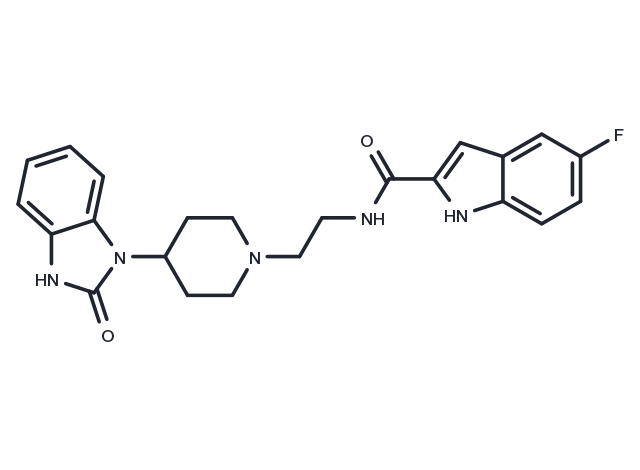Powder: -20°C for 3 years | In solvent: -80°C for 1 year


FIPI (5-Fluoro-2-indolyl deschlorohalopemide) is a derivative of halopemide which potently inhibits both PLD1 (IC50 = 25 nM) and PLD2 (IC50 = 20 nM); prevents PLD regulation of F-actin cytoskeleton reorganization, cell spreading, and chemotaxis.

| Pack Size | Availability | Price/USD | Quantity |
|---|---|---|---|
| 2 mg | In stock | $ 42.00 | |
| 5 mg | In stock | $ 68.00 | |
| 10 mg | In stock | $ 89.00 | |
| 25 mg | In stock | $ 182.00 | |
| 50 mg | In stock | $ 318.00 | |
| 100 mg | In stock | $ 497.00 | |
| 1 mL * 10 mM (in DMSO) | In stock | $ 72.00 |



| Description | FIPI (5-Fluoro-2-indolyl deschlorohalopemide) is a derivative of halopemide which potently inhibits both PLD1 (IC50 = 25 nM) and PLD2 (IC50 = 20 nM); prevents PLD regulation of F-actin cytoskeleton reorganization, cell spreading, and chemotaxis. |
| Targets&IC50 | PLD1:25 nM, PLD2:20 nM |
| In vitro | FIPI is a potent, concentration-dependent PLD2 inhibitor, and we show here that it inhibits PLD1 equally well under standard in vitro assay conditions. FIPI was added into the cell culture media 1 h before performing an in vivo PLD assay and was found to be a potent inhibitor of PLD2 with an IC50 of 10 nM.? The typical localization of PLD1 to peri-nuclear membrane vesicles and PLD2 to the plasma membrane were not affected by exposure to FIPI and and FIPI did not decrease PIP2 availability on the plasma membrane in PLD1- and PLD2-overexpressing cells as assessed using an enhanced GFP-fused PIP2 sensor. FIPI did not significantly inhibit p38 or ERK phosphorylation in bone marrow-derived macrophages stimulated with lipopolysaccharide. FIPI inhibition of PLD did diminish fMLP-directed chemotaxis(p < 0.01), validating this role for PLD function and suggesting that PLD regulates chemotaxis via mechanisms distinct from affecting MAKP signaling. |
| Kinase Assay | Phospholipase D activity is quantified using our established method of measuring the formation of [32P]-radiolabeled PBt. Cellular lipids are extracted and PBt is isolated using our published methods of lipid extraction and thin layer chromatographic separation, respectively. Radioactivity is measured using liquid scintillation counting and quantified as DPM normalized to 106 counts in the total cellular lipid extract or as percentage of control (vehicle-treated cells). |
| Cell Research | Cytotoxicity in MAECs is determined by assaying the extent of reduction in MTT in intact cells using the commercial MTT reduction assay kit. At the end of the experimental treatments, MTT solution (10% vol/vol in MEM) is added and the cells are incubated for 3 hours, following which MTT solvent is added in an amount equal to the original culture volume. Absorbance of the reduced MTT is determined spectrophotometrically, according to the manufacturer's recommendations. |
| Synonyms | 5-Fluoro-2-indolyl deschlorohalopemide |
| Molecular Weight | 421.47 |
| Formula | C23H24FN5O2 |
| CAS No. | 939055-18-2 |
Powder: -20°C for 3 years | In solvent: -80°C for 1 year
DMSO: 12.5 mg/mL (29.66 mM)
You can also refer to dose conversion for different animals. More
bottom
Please see Inhibitor Handling Instructions for more frequently ask questions. Topics include: how to prepare stock solutions, how to store products, and cautions on cell-based assays & animal experiments, etc.
FIPI 939055-18-2 Autophagy Metabolism Phospholipase Inhibitor inhibit 5-Fluoro-2-indolyl deschlorohalopemide inhibitor
